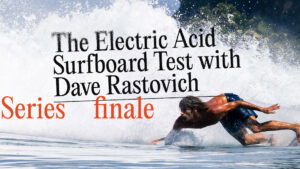Saying Goodbye To The First Surfer To Turn A Board
“I knew my destination when I was 12-years old. And I’m following that, and I’ve never doubted what my purpose was,”—George Downing, 1930-2018
Few people have made such a profound impact on surfing as George Downing, who peacefully slipped from this world in his sleep on Monday.
He was 87 years old.
Downing will be greatly missed, but he’s not gone. He was the rare breed of surfer that lives on in every wave ridden.
“I knew my destination when I was 12-years old. And I’m following that, and I’ve never doubted what my purpose was,” he said in 2012.
“Let me ask you this: do you know where your spirit is?” challenged Downing. “To connect to this, it takes a tremendous amount of effort, because you have to get rid of all the distractions. It’s pure thought, see. You can’t have anything interfere with it.”
Throughout his life, Downing remained true to his purpose. Growing up on the sands of Waikiki, he started surfing at the ripe old age of nine. By the 1940s, when Fran Heath, Wally Froiseth, John Kelly, and Woody Brown were literally taking hatchets to their redwood planks and carving the first Hot Curls, Downing was the young protégé that made the remarkable transition from going straight towards shore in the white water, to drawing a line on an open face— actually riding the wave’s face.
Today, we take that for granted, of course. Our boards have become highly tuned micro machines and some of the best performances are done above the lip. But without Downing and crew developing the Hot Curl, and his inclination to head for the open face, who knows where we’d be right now.
“Hot curls were difficult to get started (paddling),” recalled Downing. “But once you got going, you’d really move along. Down the line you’d go fast. Your limitations were that once you got locked into it, you could just ease down and back up again and still maintain a lot of forward momentum.”
As Downing and company refined their boards and got their lines wired around Town, they looked to expand their horizons.
“Makaha came into play after [John] Kelly camped there on a dive trip and returned home raving about the surf. Makaha Point became the new frontier and George an eager explorer,” reads the family history at DowningSurf.com.
With the big-wave universe just starting to come into perspective, Downing continued to innovate. In ’51 he took one of his balsa planks and carved a “slot” in the bottom, creating the first-ever fin box. He called the board “The Rocket.”
“In the early days I didn’t know quite where the optimum place was to position my fin,” explained Downing. “I couldn’t keep glassing my fin on, then remove it, and reglass it…that was a pain in the ass. So, I began thinking of some way I could attach my fin to my board without having to glass it on. Knowing about sailboats and the different wood used for sailboat construction, I made the first fin box out of wood with a groove in it so you could take the fin in and out, plus it would enable me to experiment with different size fins.”
Downing wielded his athletic prowess and engineering intellect mightily. He won the ’54 Makaha International Surfing Championship—the first major contest in the sport’s history. He ran it back in ’61 and ’65.
Downing also showed up in some of the early surf movies, including Cat on a Hot Foam Board (1959), Cavalcade of Surf (1962) and Gun Ho! (1963), as well as a feature spot on Duke Kahanamoku’s 1968 CBS special, World of Surfing.
As boards (and fins) improved, the attention turned from the westside of Oahu to the unridden realm along the North Shore. Downing always preferred the longer lines at Makaha to the short drops at Waimea, but that’s not to say he didn’t have a hand in what was going on there at the time.
In 1985, Downing became contest director for the Quiksilver in Memory of Eddie Aikau.
“The Bay calls the day,” he would famously say in regards to the requirement that Waimea be at least 20-foot to hold the contest.
Downing and The Eddie would usher in a new era of high profile big-wave surfing, creating the foundation for other events at places like Mavericks and Jaws, as well as the Big Wave World Tour.
The reach of Downing’s life is simply too expansive to summarize here. He was a surfing champion, a surfboard craftsman, a pioneer, a businessman, a teacher, an environmentalist, an explorer, a thinker, an innovator, a friend, a father, and Uncle to so many surfers, especially in the Islands.
Through it all, Downing remained true to who he was. For the most part, he didn’t grant interviews or deal to much with the press.
“I’m kind of a private person,” explained Downing. “Not because I think I’m special, it’s just that we all have that private part of us that we want to keep private.”
Deeply spiritual in his own way, from the first waves he rode when he was nine all the way until he left this world, the ocean was always his sanctuary.
“Thank god people take the time for meditation, or to go up in the forest. This is what I found in the ocean,” said Downing. “I was totally a peace out there. I could go out there and just watch it, you know. Just watch it, be out there, spend hours, hours, and be at total peace.”















Comments
Comments are a Stab Premium feature. Gotta join to talk shop.
Already a member? Sign In
Want to join? Sign Up